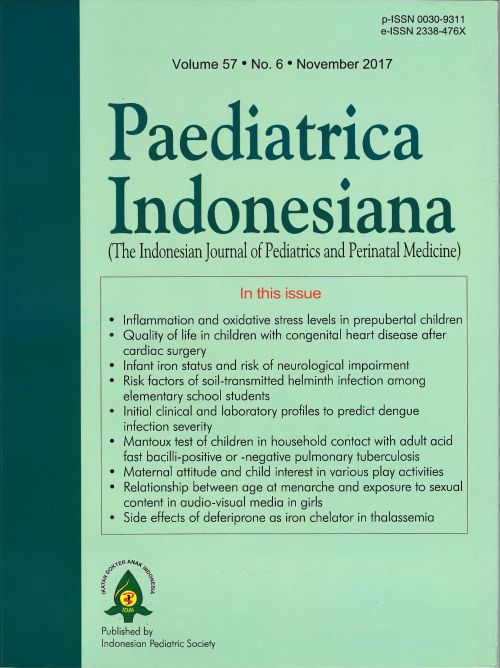The relationship between infant iron status and risk of neurological impairment
DOI:
https://doi.org/10.14238/pi57.6.2017.291-4Keywords:
iron deficiency, infant neurological development, Bayley Infant Neurodevelopmental Screener, BINSAbstract
Background Iron deficiency (ID) is a commonly found nutritional disorder and a persistent problem, especially in Indonesia. Iron deficiency during the critical period in childhood brain development is estimated to cause irreversible damage that hinders infant development.
Objective To determine the relationship between infant iron status and neurological development.
Methods We conducted a cross-sectional study at the Growth and Development Outpatient Clinic, Prof. Dr. R. D. Kandou Hospital, Manado, from March to May 2015. By consecutive sampling, we obtained 44 healthy infants aged 7 to 10 months who fulfilled the inclusion criteria. Infants with a history of perinatal complications, such as head trauma, hypoglycemia, respiratory distress syndrome, infection, or malaria were excluded Subjects' serum hemoglobin and ferritin were examined for iron status. Infants' risk of neurological impairment was assessed by the Bayley Infant Neurodevelopmental Screener (BINS). Results were analyzed by descriptive analysis for the characteristics and Spearman's rank correlation coefficient analysis for the relationship between iron status and neurological development.
Results From 14 infants with ID, 8 infants had a high risk of developmental impairment. Of the 30 non-ID subjects, 4 infants had a high risk of developmental impairment. Of the 30 non-ID infants, 16 infants had a low risk of impaired development, while 2 infants with ID had low risk of developmental impairment. Spearman's rho revealed that infant iron deficiency was significantly associated with high risk of neurological impairment. (r=-0.547; P<0.0001).
Conclusion Lower serum ferritin levels (iron deficiency) is significantly associated with greater risk of impaired neurological development in infants aged 7-10 months.
References
2. Wahidayat I. Masalah anemia pada anak di Indonesia. In: Abdulsalam M, Trihono P, Kaswandani N, Endyarni B, editors. Pendekatan praktis pucat: masalah yang terabaikan pada bayi dan anak. Pendidikan Kedokteran Berkelanjutan Ilmu Kesehatan Anak. Jakarta; IDAI: 2007. p. 1-3.
3. Ringoringo HP. Insidens defisiensi besi dan anemia defisiensi besi pada bayi berusia 0-12 bulan di Banjarbaru, Kalimantan Selatan: studi kohort prospektif. Sari Pediatri. 2009;11:8-14.
4. Yadav D, Chandra J. Iron deficiency: beyond anemia. Indian J Pediatr. 2011;78:65–72.
5. Dallman PR, Yip R, Oski FA. Iron deficiency and related nutritional anemia. In: Nathan DG, Oski FA, editors. Hematology of infancy and childhood. 4th ed. Philadelphia: WB Saunders; 1993. p. 413-41.
6. Iron deficiency anaemia. Assessment, prevention, and control. A guide for programme managers. Geneva: WHO; 2001. p. 33-7.
7. Pusponegoro HD. Bayley Infant Neurodevelopmental Screener: Skrining Anak 3-24 bulan. Presented at the Nutricia Scientific Workshop; 2003. Neurodevelopmental assessment in young children: the importance of subtle signs and symptoms of developmental problems. 2003 September 1-2; Manado.
8. Hidajat B, Lestari ED. Defisiensi zat besi. In: Sjarif DR, Lestari ED, Mexitalia M, Nasar SS, editors. Buku ajar nutrisi pediatrik dan penyakit metabolik. Jilid I. Jakarta: Badan Penerbit IDAI; 2011. p. 190-208.
9. Lozoff B, De Andraca I, Castillo M, Smith JB, Walter T, Pino P. Behavioral and developmental effects of preventing iron-deficiency anemia in healthy full-term infants. Pediatrics. 2003;112:846–54.
10. Apriyanti WS, Sutaryo S, Mulatsih S. Serum ferritin to detect iron deficiency in children below five years of age. Paediatr Indones. 2013;53:150-4.
11. Wu AC, Lesperance L, Bernstein H. Screening for iron deficiency. Pediatr Rev. 2002;23:171-8.
12. Skalicky A, Meyers AF, Adams WG, Yang Z, Cook JT, Frank DA. Child food insecurity and iron deficiency anemia in low-income infants and toddlers in the United States. Matern Child Health J. 2006;10:177-86.
13. Cook JD, Boy E, Flowers C, Daroca Mdel C. The influence of high-altitude living on body iron. Blood. 2005;106:1441-6.
14. McCann JC, Ames BN. An overview of evidence for a causal relation between iron deficiency during development and deficits in cognitive or behavioral function. Am J Clin Nutr. 2007;85:931-45.
15. Beard JL. Why iron deficiency is important in infant development. J Nutr. 2008;138:2534–6.
16. Lozoff B. Early iron deficiency has brain and behavior effects consistent with dopaminergic dysfunction. J Nutr. 2011;141:740S–6S.
17. Li Y, Kim J, Buckett PD, Bohlke M, Maher TJ, Wessling-Resnick M. Severe postnatal iron deficiency alters emotional behavior and dopamine levels in the prefrontal cortex of young male rats. J Nutr. 2011;141:2133–8.
Downloads
Published
How to Cite
Issue
Section
License
Authors who publish with this journal agree to the following terms:
Authors retain copyright and grant the journal right of first publication with the work simultaneously licensed under a Creative Commons Attribution License that allows others to share the work with an acknowledgement of the work's authorship and initial publication in this journal.
Authors are able to enter into separate, additional contractual arrangements for the non-exclusive distribution of the journal's published version of the work (e.g., post it to an institutional repository or publish it in a book), with an acknowledgement of its initial publication in this journal.
Accepted 2017-12-11
Published 2018-01-05


















